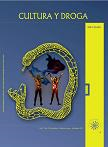Authors
Abstract
Article founded in the graduation requirement of its author for completion of requirements for receiving the Diploma as Anthropologist at Universidad de Caldas: Silent voices and their meanings: cannabis consumers from Cartago, an anthropologic study of cannabis consumption in commune 4.” It is the ethnographic chapter in which the phenomena is approached exclusively from the consumers themselves, from an emic perspective from which they have been excluded, stigmatized and silenced because of the moral speech, One of the specific objectives was to distribute/interpret (restarting Geertz) and to understand social representations in young consumers about marihuana addiction which will be presented right after, but not without knowing some methodological and contextualization elements. Methodology: The research methodology was the systematic use of procedures, techniques and instruments proper of the ethnographic method. The methodological approach had several stages: preparatory stage which started from the final adjustments to the research project elaboration in which the research questions and the study objectives which determined the method to be used. During this first stage the secondary sources location, the extension of bibliographic references, images, musicography, audiovisual materials and other related information started. Similarly, the first contact with cannabis consumers was established. The process continued with an information compilation stage, for which purpose two techniques were mainly used: interviews and participant observation as well as some research instruments such as a photo camera, tape recorder and video. The field work was carried out between January 2011 and June 2012. Population: Men (mostly) and women between 16 and 17 years old became the object population for the study. Most of them were born and raised in Cartago. Their main activity was related with their family (they are children, brothers, sisters or parents), as well as athletes, public and private school, technical institutes or university students; similarly, some of them develop working activities as secretaries, office workers, sellers, mechanics, professionals, etc. During the time the research was carried out, some of them were unemployed searching for working opportunities.
References
Aguirre Baztán, A. (coord. 1995 Etnografía. Metodología cualitativa en la investigación sociocultural. Barcelona, Marcombo.
Araya, S. (2002). Las representaciones sociales: Ejes teóricos para su discusión. Cuaderno de Ciencias Sociales 127. San José, Costa Rica: FLACSO.
Arcia, J.H. (2010). La marihuana también evoca experiencias psíquicas colectivas. Imágenes simbólicas que subyacen a la embriaguez con marihuana. Revista Cultura y Droga, 15(17), 17-27.
Ausbel, D.P. (2002). Adquisición y retención del conocimiento. Una perspectiva cognitiva. Barcelona: Paidós.
Barona, G. (2012). Entre el placer y el hastío, otra mirada al consumo, a la adicción, y a la prohibición de las drogas. Bogotá: Deriva Ediciones.
Bateson, G. (1993). Espíritu y naturaleza. Buenos Aires: Amorrortu Editores.
Botero, P. (2008). Representaciones y ciencias sociales: una perspectiva epistemológica y metodológica. Buenos Aires: Espacio.
Camacho, A. (1989). Droga y sociedad en Colombia: el poder y el estigma. Bogotá: IEPRI, Universidad Nacional de Colombia.
Concari, R. (2006). Escritura: de las representaciones sociales a las prácticas. Revista Hermes, 1. Disponible en: http://www.ifdcsanluis.edu.ar/hermes/recherche.php3?recherche=volumen+&lang=es
Eliade, M. (1981). Lo sagrado y lo profano. México D.F.: Guadarrama / Punto Omega.
Fericgla, J.M. (2000). El arduo problema de la terminología. Revista Cultura y Droga, 5, 3-20.
Fernández, C.F. (2008). ¿Qué es el popper y cuál es su uso? (Video). Disponible en: http://www.youtube.com/watch?v=cvEjTqOH0FM
Geertz, C. (1988). La interpretación de las culturas. Barcelona: Gedisa.
Hachamayor, A. (2008). Marihuana, planta maestra. Aspectos estéticos y éticos de la cannabis sativa. Revista Cultura y Droga, 13(15), 111-134.
Loebl, S.; Spratto, G. y Heickheimer, E. (1988). Manual de farmacología. México, D.F.: Editorial Limusa.
Malpica, K. (2003). ¿Qué es y cómo actúa una droga psicoactiva? Revista Cultura y Droga, 10, 281-295.
Molina, M.M. (2008). El cannabis en la historia: pasado y presente. Revista Cultura y Droga, 13(15), 95-110.
Ott, J. (2006). Escenarios farmacológicos de la cocaína en Manizales: “patraseando” por la pocaína a la nocaína: del bazuco al ladruco. Revista Cultura y Droga, 11, 49-59.
Perdomo, R. y Climent, C. (1989). El síndrome depresivo. En: Climent, C. (Ed.), Lo esencial en Psiquiatria. Cali: Talleres Gráficos de Impresora Feriva Ltda.
Restrepo, L. (2001). La fruta prohibida, la droga como espejo de la cultura. Bogotá: Panamericana Editorial.
Ronderos, J. (2001). Mimetismo cultural, divertimento y drogas. Revista Cultura y Droga, 6-7, 9-26.
Saussure, F. (1945). Curso de lingüística general. Disponible en: http://old.liccom.edu.uy/bedelia/cursos/semiotica/textos/saussure_linguistica.pdf
Zamudio, T. y Ronderos, J. (2012). Percepciones culturales sobre las prácticas e imaginarios del uso de drogas ilícitas (marihuana) y lícitas (bebidas alcohólicas - cerveza) en jóvenes de 12 a 18 años en 16 ciudades de Brasil. Instituto de Investigación, Universidad del Museo Social Argentino.
MUSICOGRAFÍA
Cartel de Santa. (2003). Cannabis. CD. México, D.F.: Sony Music. Control Machete. (1998). La artillera. En Artillería Pesada Presenta. CD. México, D.F.: PolyGram
Cultura Profética & De la Ghetto. (2009). Yo fumo (I love marihuana): Mixtape.
Grupo Niche. (1992). Droga. En Llegando al 100%. CD. Cali: Sony Music.
Raíces y Cultura. (2004). Mr. Babilon. En Mística raíz. CD. Ciudad de Panamá: Independiente.
Ras Mael & Jah Bantu. (2011). Hierba santa. En Jah is love. CD. Madrid: Indica Sound.
Swan Fyahbwoy. (2006). Por fumar. En Ni Chance Ni Try. CD. Madrid: Fyahbwoy.
Zona Ganjah. (2003). Ganjahman. En Con ayuda del error. CD. Buenos Aires: Independiente.

 PDF (Español)
PDF (Español)
 FLIP
FLIP

















